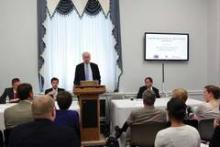Scientific advisers from the AGA’s Center for Gut Microbiome Research and Education went to Capitol Hill in late July to make a pitch for increased research funding, including for the National Institutes of Health’s Human Microbiome Project.
The advisers – Rob Knight, Ph.D., Dr. Martin J. Blaser, and Dr. Gary D. Wu – along with AGA President Loren A. Laine, briefed congressional staff on the science of the gut microbiome and the importance of delving further into its workings.
"There’s no question that understanding and manipulating the gut microbiome will be very important in attacking diseases, and how we take care of patients’ diseases in the future," said Dr. Laine.
Dr. Knight, an associate professor of chemistry at the University of Colorado, Boulder, and a career scientist with the Howard Hughes Medical Institute, gave an overview of the field, focusing on what’s been collected so far by the Human Microbiome Project. The HMP, begun in 2007, aims to characterize the healthy human microbiome by sampling 300 subjects (from 15 body sites on men and 18 sites on women).
So far, the HMP data have shown that humans have unique microbiome "fingerprints." We are 90% different, with microbes differing according to age, sex, and geographic area – and possibly by other parameters, as well. Getting the genomic fingerprint of the microbiome is important because microbes can help determine, for instance, whether certain drugs might cause liver toxicity or make a person more attractive to mosquitoes, said Mr. Knight. The HMP, however, is limited to studying healthy Western adults.
Dr. Knight is a collaborator on the American Gut Project, which is using crowd-sourced samples to further examine the makeup of the gut microbiome. So far, several thousand people from around the world have participated. It is funded by $99 "donations," from each participant, which cover the cost of the sampling kit. The donations go to the Biofrontiers Institute at the University of Colorado, Boulder, and the Earth Microbiome Project.
There is a need for faster DNA sequencing, databases of normal and abnormal microbiomes to provide a baseline, and research into how the microbiome affects health, including longitudinal studies to predict and monitor health changes, and animal models to help establish causality, said Dr. Knight.
Dr. Blaser, professor of microbiology and director of the Human Microbiome Program at the New York University Langone Medical Center, said findings so far had stimulated interest in researching the identity of various microbes, their activities, how the human host responds to microbes, the forces that maintain equilibrium in the host, and the unique characteristics of each individual’s microbiome. He and others have been looking into how antibiotic use in childhood might be affecting obesity. Studies have shown a correlation between heavy antibiotic use in certain areas of the country and greater rates of obesity in those same areas, said Dr. Blaser.
Antibiotic use may also be leading to less diversity in the guts of American adults, he said. There is a need for more research on the consequences of antibiotic use, and to help produce better diagnostics and therapies that are more narrowly targeted, he said. It would also be useful to examine the potential for both prebiotic and probiotic therapies, Dr. Blaser said.
Dr. Wu, professor of medicine at the University of Pennsylvania, Philadelphia, briefed the attendees on the success of fecal transplants to treat Clostridium difficile. So far, the procedure has offered proof of principle that human microbiota can be modified to treat disease, said Dr. Wu. It also has provided a window into the biology of the gut microbiome.
But "we must be very cautious," said Dr. Wu, noting that there are no data on short-term or long-term consequences of fecal transplant. The gut includes bacteria, fungi, and viruses, many of which have not been fully characterized yet, and is a "dynamic and living consortium that can change over time in ways that scientists cannot fully predict," said Dr. Wu.
He noted that clinicians had accidentally infected a generation of patients with hepatitis C through blood transfusions, because hepatitis C virus had not been discovered yet.
In the future, the aim is to standardize the process – both in creating the material to be transplanted and the conditions under which it is given, said Dr. Wu. There is also a need for functional studies in humans, to determine how the transplants work. Finally, he said, "it’s of tremendous importance that there be a register so people can be tracked for short- and long-term safety."



